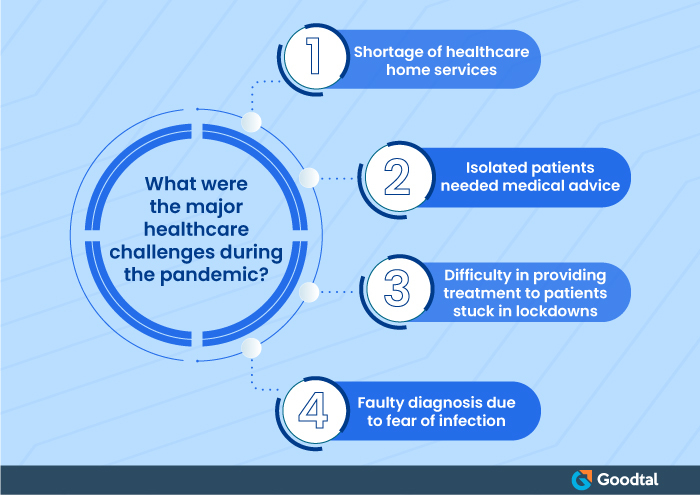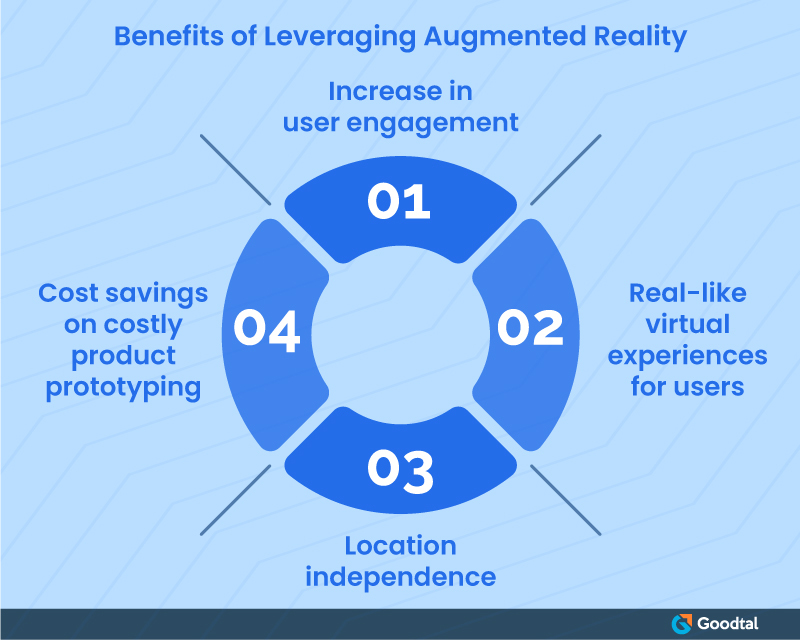
In this era of smartphones, the best way to reach out to customers is through apps. However, businesses must develop exceptional apps to compete in this demanding market. Successful apps rely on cutting-edge technology to attract customers, retain them, increase engagement, and offer outstanding user experiences.
Augmented Reality is one such technology that gives an exciting user experience. Augmented Reality has always fascinated the users in all its applications. This technology layers or overlays the real on the unreal to offer users real-like and interactive virtual experiences.
As more and more businesses have started leveraging AR as their formula for success, AR is gaining immense popularity in various industries.
Top Industries Adopting Augmented Reality to Drive Success
Different industries are increasingly adopting Augmented Reality solutions. Let’s summarize how AR is contributing to the transformation of major industries.

Real Estate
The real estate sector across the world was badly hit by the Covid-19 pandemic. The economy was affected, making people apprehensive about their financial stability and future income. Commercial real estate also suffered setbacks as most businesses shifted to the work-from-home model. In such times, not many could think of buying commercial or residential properties.
Despite the limiting times, some real estate businesses could achieve their market share because the real estate demand never vanished; only the preferences changed. The businesses that adapted to these changing preferences survived the competition. The key is to prepare for such crises by using technology.
Display Properties Virtually
Businesses using apps with Augmented Reality are able to survive in the real estate market irrespective of the circumstances. Instead of asking the customers to visit their properties, they show the properties to the customers through apps. The customers thus do not have to go to far-off locations and can still see detailed information about the ready-to-move property along with augmented reality enabled 360-degree views.
Visualize Under-Construction or Yet-to-be-Constructed Properties
So, this was about selling existing properties through apps. However, displaying the yet-to-construct or under-construction properties is more challenging for real-estate businesses. The former doesn’t exist, and the latter is risky to show. These types of properties are displayed through prototypes. 2D images are very limiting in demonstrating the intricacies of the property. And 3D modeling in real estate, though a good reference for real estate professionals, would not give a convincing view to the customers. Physical modeling can be very costly and time-consuming. Moreover, after spending enough time and money, the prototype is still ineffective for users who can’t move in and around.
Businesses can use Augmented Reality for building user experiences on their virtual prototypes that can offer real-like views to the customer through their smartphone camera. These AR-based prototypes can be viewed on apps by prospective buyers who can see themselves moving around the property virtually though the property is not constructed yet. Also, they can suggest their preferences and modifications at a stage where these are easy to incorporate. Moreover, the real estate contractors and agents can also show them the effect after incorporating their preferences and help them eliminate the requirements which result in irrational solutions.
Healthcare
After the Covid-19 pandemic, the focus across the world has shifted to the healthcare sector and its limitations. Here are the major healthcare challenges that the pandemic highlighted.

Research and development in this sector have increased manifold to overcome the challenges and enable the human race to fight future pandemics.
Increase in Awareness
Augmented reality is a game-changer in the healthcare sector. During the pandemic, many people started using telemedicine apps that list doctors for online consultations. You can reach your specialist through audio or video calls, and you are not even limited by location. But, not all patients understand their medical problems or anatomy to be able to describe the problems to the doctor. This limits the scope of diagnosis and treatment. AR can convert 2D images into 3D. So, doctors can explain concepts to their patients even without being physically present using AR apps. Patients then can use this information to understand their condition and describe it to the doctor.
Reduces Patient Apprehensions
AR is used to show 3D virtual previews of prospective procedures that the patient has to undergo, thus reducing the lack of knowledge and increasing confidence in the patient. AR-based training apps can also guide patients on post-surgical self-care and post-discharge routines.
AR apps increase awareness among patients and help healthcare training reach remote areas that do not have any access to it physically. Thus, AR has removed location and time barriers in dispensing healthcare.
Training
In remote and rural areas where such medical facilities cannot reach, the specialists can train the medical practitioners through AR-based material and demos, including the representations of surgical procedures. Case-based AR simulations can easily be developed to guide medical students or junior doctors about various medical procedures.
AR-based healthcare will also help doctors and healthcare workers in so many ways. These can give access to real-like case studies of the latest major successful medical procedures. This can take the medical profession to the next level by increasing awareness and confidence. It will also shrink the world and make healthcare accessible to countries unable to afford high-level healthcare facilities.
E-commerce
Ecommerce is widely leveraging Augmented Reality to attract more traffic, increase engagement, and give the best user experience to the customers.
Interactive Product Manulas
Many customers like to buy from brick-and-mortar stores as they want to see the product from all angles. In fact, in online buying, the product often comes as a shock after it is delivered. But, interactive product manuals with Augmented Reality offer a display of products virtually through an app. The entire range of products in the store can be searched and reached easily with simple clicks. The Augmented Reality based experience allows each product to be seen in 3D, so there is no doubt about how it appears from all the dimensions. AR-based interactive product manuals are not just exciting but also offer the next level of user experience, the future of ecommerce!
Virtual Product Trial
Clothes and accessories often do not give the right picture in images and can look very different for each customer. So, most customers prefer to try these on before buying. Augmented reality offers virtual, app-based product try-before-buy to the customer. The customer can use his camera to overlay the product and his picture. So, it's easy to try many products in a short time.
A virtual trial using AR is not just a 3D visualization or video; it, in fact, shows how the product looks on the customer by augmenting the customer and product over his image captured by the camera. Trying the product in the store is a bigger hassle when the customers have to wait in queue for their turn.
The customer does not even need to visit his favorite store located at a distance or even in another city or state to try the product. For people who are too busy to go to their favorite stores, it is a store-at-home experience giving customers the privilege of try-before-buy at the convenience of their home. Such experiences attract customers to switch from physical stores to apps for shopping without compromising product trials.
Benefits to Ecommerce Service Providers
As the business shifts to apps more than physical stores, ecommerce providers get huge cost savings when not required to maintain large stores and resources therein. Also, during the pandemic, people were apprehensive about visiting stores for purchases. Ecommerce players who incorporated AR-based app experiences did not suffer from any disruption as their sales continued uninterrupted through apps without going through the risk of putting employees and customers at risk of infection.
Moreover, AR also adds entertainment and fun to app-based shopping, which keeps the customer attracted to your app.
Travel
Who doesn’t like to travel to get away from boring routines? But, vacations to far-off destinations can be really costly on time and money. So, it's difficult for most customers to choose a destination without knowing what it offers. AR-based apps can offer real-life travel experiences to customers. Excited to know how?
Trying Different Destinations
The travel industry offers products that are difficult to reach and try before buying. No customer wants to pull out time from his busy schedule for a vacation that lands him in a place that makes him regret his decision. Most busy customers have to go through disappointments in travel when their expectations dont meet the reality, and the travel businesses have to face the brunt of dissatisfied customers.
A successful business offers its customers clarity to bridge the gap between expectations and reality. How we wish our customers could try different destinations before selecting one! Is that possible?
A travel app becomes more engaging with AR as it helps bridge the customer's expectations and reality with real-like previews of selected destinations. He can just scroll over the app and try different destinations without visiting any of them physically.
Real-like Experience of Chosen Destination
AR-apps allow the customer to view and feel a part of all the tourist spots in the chosen destination. They can feel as if they are moving around on the streets, seeing famous monuments, and interacting with the environment virtually.
Better Orientation While on Real Travel
Have you ever felt lost when traveling to a new place? AR apps not just offer virtual travel experiences, but they can also help users stuck in travel. Such apps give information about the place where the user is moving around. It can capture and identify the language of the banners, posters, and information boards and translate it for the user in his language. It can give details about a menu item in a restaurant so that the user knows what he is trying. So, it helps as a guide to reduce the customer’s anxiety in a new place with a different culture. It enables the user to safely navigate even when he can't find any help due to language or location barriers.
Travel Without Traveling
Tourism businesses can offer virtual travel experiences even to customers who can’t travel. Through AR apps, tourism businesses can offer travel games and travel destinations virtually through AR apps. Who would not love your app if it gives them the experience they can’t buy but wish they could!
Education
Generations will keep progressing. With each generation, the education sector goes through major overhauls. While we got classroom-based education and paper books, the pandemic forced the students of the current generation to learn at home using smartphones, laptops, and apps. Trends and preferences are shifting towards technology. Remember, the students now are more demanding than the previous ones when it comes to technology, and the education sector will have to provide them with what they want as they are the future of education.
Removing Location & Time Barriers
The Covid-19 pandemic has encouraged the concept of self-learning and learn-from-anywhere. The students of these times need access to resources and teachers anywhere and anytime. Plus, they want the experience to be engaging! Traditionally it was considered challenging to offer home-based learning to students as the experiential elements were absent. However, Augmented Reality has helped the education industry overcome this limitation by providing anytime, anywhere, real-like experiential learning at the click of a button. Students can undergo practical lab experiences through augmented reality apps.
Interactive Course Material & Resources
The educators are now more resource providers. Activity-based learning involves teachers allowing the students to interact and participate in activities that help them understand the concept better. AR-based 3D augmentation can make even tricky Physics and Biology concepts easy to understand through smart learning resources like AR-based study material in apps. In summary, AR has made learning more action-oriented, experiential, engaging, and interactive.
Augmented Reality is the Future!
The top mobile app developers are already leveraging AR to offer great user experiences. Some benefits of AR are common to almost all industries. The infographic here shows the different benefits of Augmented Reality to various sectors.

Businesses from different sectors are leveraging AR-based apps. AR helps in customer engagement and retention and saves costs and time on product prototyping. Thus, we know that Augmented Reality apps are the future of successful businesses!
If your business needs Augmented Reality solutions, always go for the best AR-development company to help you overcome all the challenges.
